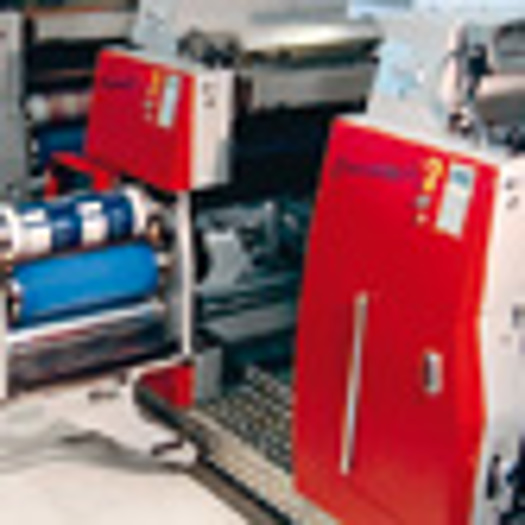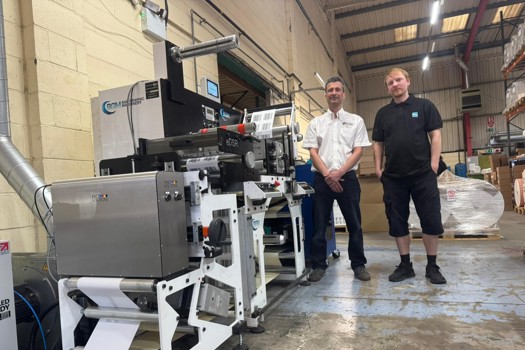The narrow-web presses are designed as a modular production lines, so it’s possible to add additional colour stations as well as finishing units all inline. For a mature technology, the narrow-web flexo sector has seen a number of trends gather pace in recent years, which we’ll illustrate here with reference to five recent presses.
The most obvious trend is the growing use of digital technology, with most flexo press vendors now offering some form of hybrid. In some cases this means a single printhead for adding variable data to colour flexo printed images, but several flexo presses incorporate full-colour inkjet. The best example of this is the Gallus LabelFire (which was originally launched last year as the DCS340). It’s based around the chassis of a Gallus ECS340 flexo press and has the same 340mm web width, and accepts all the units developed for this press. It has two flexo units and a flexo varnish unit as well as the inkjet module that was developed with Fujifilm, using the proven Samba printheads.
These printheads offer a relatively high resolution of 1,200dpi, with a tiny 2pl drop size. It can run at 45m/min, which is slow for a flexo press but fairly standard for inkjet label presses. It’s an eight-colour machine, having CMYK plus orange, green and violet as well as white. Jason Oliver, vice-president of digital printing at Gallus owner Heidelberg, says that the firm has developed the UV inks, which are sold under its Saphire brand.
It’s also worth noting that many flexo presses can accommodate other print processes inline, such as offset or gravure, so that adding digital isn’t really that radical.
James Boughton, managing director of press manufacturer Edale, suggests that another major trend is for greater automation, noting: “There is more demand for automatic control of print settings. And more controls for register and print settings and automation to set up for things like finishing, slitting and die cutting”.
He says that this is driven by the need to compete with digital presses by automating makeready for faster job changeovers and making shorter runs more economical. He adds: “This automation is reducing the reliance on operators to make all the changes that they would normally make to have the machine produce at a certain quality and productivity.” This leads to more consistent results that are less dependent on a particular operator’s skills, and also makes it easier to train people to run these presses.”
Thus most modern flexo presses exhibit a high degree of automation. The Edale F3, for example, can be set up in less than 10 minutes and offers pre-registration on the print stations together with automatic registration during a print run and a self-cleaning plate system. There’s a choice between 350mm and 430mm web widths and it can print at 200m/min.
Motor heads!
There’s a noticeable increase in the use of servo motors, which is only partly to do with the general trend for more automation. As Anthony Cotton, sales manager for Focus Label Machinery, explains: “A servo gives more control. Things like auto registration are a bit easier particularly if you want to do something like flexible film which is a little bit less stable than paper.” He says that customers aren’t necessarily looking to use films, but just to have the flexibility to handle different substrates should the need arise.
However, servos are expensive and will push press prices up. Consequently many machines use a line shaft combined with some servos used to add control of particular features. Another option is to use a single servo to drive the entire press, which does keep the cost down but puts a lot of stress on that motor. Cotton notes: “The more servos there are the more control you have over individual elements.”
Focus offers customers a choice for its modular Proflex press, which is aimed at the upper end of the market. The SE version uses servo drives on each print station, while the E model uses a line shaft drive. It’s available in 250mm and 330mm widths and can take up to 10 colours. It includes slitting and rotary die-cutting with options for LED UV curing and IR curing and IR drying. Recent updates include a touchscreen operator panel, with the ability to archive jobs for future reference and servo-assisted controls.
How wide is narrow?
There is a growing consensus among the press manufacturers that narrow-web presses are also getting wider. Specifying a wider web does open up more application possibilities, allowing a converter to compete for some packaging work, without having to invest in a CI flexo press. This goes hand in hand with fitting servo motors to handle the film-based substrates.
Cotton says that label presses used to be 250-330mm but now the 330-430mm machines tend to be more popular. He adds: “I would say this is more compatible with digital presses.”
Several vendors offer web widths of 530mm but Bobst has gone a step further with its M6, which has a print width of 630mm and is really targeted at the packaging rather than the label market. This is a full servo press capable of running at 200m/min. It can handle glossy paper of 60-100gsm, flexible films, aluminium foil and cardboard up to 350gsm. It also includes Bobst’s Digital Flexo concept, which essentially means automating as many processes as possible to reduce changeover time and waste.
Finally, many vendors are betting that we’ll see more demand for UV LED curing. Most label presses run with UV inks and LED curing can reduce power usage and service costs. However, the initial investment is expensive and so far there’s little evidence that UK label converters are investing heavily in LED curing but the press vendors are confident this will change.
There are several different systems to choose from. Omet, for example, has chosen to work with US company AMS after a customer, ACM in Italy, had the AMS XP system installed on to its Varyflex V2 press. Marco Calcagni, sales director for Omet, says that the company was so impressed by this installation that it opted to work directly with AMS and to offer its XP system with new presses. This was demonstrated at last year’s Label Expo show with a hybrid XFlex X6 Digital. The XP LED units are solid-state modules that use a water-based chilling system. It’s possible to join up to 20 of them together and they also work alongside conventional UV lamps.
The X6 press is available in three sizes of 340mm, 430mm and 530mm, each capable of speeds up to 200m/min. The X6 is fully servo driven with independent motors and optional register control. As well as the flexo print units it can also be fitted with offset, digital and rotogravure imaging, as well as die cutting and matrix stripping. It will support flexible films, aluminium packaging, such as blister packs, and folding carton substrates.
In addition, there are a couple of other trends that are also worth mentioning. Firstly, most newer presses are designed with a short web path, sometimes as short as 1.3m, which means that considerably less material is being wasted in setting up the press. This is an important consideration given that margins tend to be fairly tight in the label sector.
There is also a trend towards more colours, with several press vendors reporting installations with 10 colours or more as converters look to distinguish their capabilities from the competition.
Conversely, there is also a movement towards using less colours with an extended or fixed colour gamut inkset. The idea is that using a fixed inkset cuts down the makeready times between jobs. This typically involves seven colours, though Dan Pulling, business development manager for Esko, argues that four colours should be enough for the majority of work. Bobst has been a major proponent of using extended colour gamuts as part of its Digital Flexo concept.
Ultimately, all of the technology advances that we’ve covered here add up to one dominant trend to enable label printers to cater for more packaging work. Ironically, several of the smaller wide web flexo presses have been designed to run multiple webs side by side so that they can compete for label work.
The choice depends on volume but most vendors agree that run lengths are coming down and that brands are seeking fast turnaround both on labels and packaging, which is one reason for investing in a narrow web press, with all the production processes, including finishing, inline on a single device.










